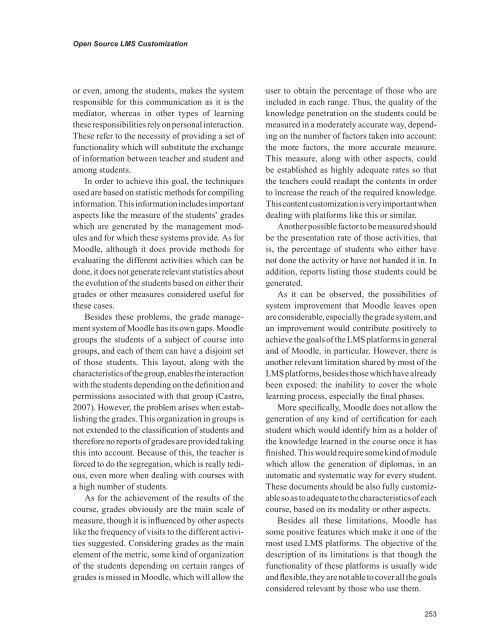Advances in E-learning-Experiences and Methodologies
You also want an ePaper? Increase the reach of your titles
YUMPU automatically turns print PDFs into web optimized ePapers that Google loves.
Open Source LMS Customization<br />
or even, among the students, makes the system<br />
responsible for this communication as it is the<br />
mediator, whereas <strong>in</strong> other types of learn<strong>in</strong>g<br />
these responsibilities rely on personal <strong>in</strong>teraction.<br />
These refer to the necessity of provid<strong>in</strong>g a set of<br />
functionality which will substitute the exchange<br />
of <strong>in</strong>formation between teacher <strong>and</strong> student <strong>and</strong><br />
among students.<br />
In order to achieve this goal, the techniques<br />
used are based on statistic methods for compil<strong>in</strong>g<br />
<strong>in</strong>formation. This <strong>in</strong>formation <strong>in</strong>cludes important<br />
aspects like the measure of the students’ grades<br />
which are generated by the management modules<br />
<strong>and</strong> for which these systems provide. As for<br />
Moodle, although it does provide methods for<br />
evaluat<strong>in</strong>g the different activities which can be<br />
done, it does not generate relevant statistics about<br />
the evolution of the students based on either their<br />
grades or other measures considered useful for<br />
these cases.<br />
Besides these problems, the grade management<br />
system of Moodle has its own gaps. Moodle<br />
groups the students of a subject of course <strong>in</strong>to<br />
groups, <strong>and</strong> each of them can have a disjo<strong>in</strong>t set<br />
of those students. This layout, along with the<br />
characteristics of the group, enables the <strong>in</strong>teraction<br />
with the students depend<strong>in</strong>g on the def<strong>in</strong>ition <strong>and</strong><br />
permissions associated with that group (Castro,<br />
2007). However, the problem arises when establish<strong>in</strong>g<br />
the grades. This organization <strong>in</strong> groups is<br />
not extended to the classification of students <strong>and</strong><br />
therefore no reports of grades are provided tak<strong>in</strong>g<br />
this <strong>in</strong>to account. Because of this, the teacher is<br />
forced to do the segregation, which is really tedious,<br />
even more when deal<strong>in</strong>g with courses with<br />
a high number of students.<br />
As for the achievement of the results of the<br />
course, grades obviously are the ma<strong>in</strong> scale of<br />
measure, though it is <strong>in</strong>fluenced by other aspects<br />
like the frequency of visits to the different activities<br />
suggested. Consider<strong>in</strong>g grades as the ma<strong>in</strong><br />
element of the metric, some k<strong>in</strong>d of organization<br />
of the students depend<strong>in</strong>g on certa<strong>in</strong> ranges of<br />
grades is missed <strong>in</strong> Moodle, which will allow the<br />
user to obta<strong>in</strong> the percentage of those who are<br />
<strong>in</strong>cluded <strong>in</strong> each range. Thus, the quality of the<br />
knowledge penetration on the students could be<br />
measured <strong>in</strong> a moderately accurate way, depend<strong>in</strong>g<br />
on the number of factors taken <strong>in</strong>to account:<br />
the more factors, the more accurate measure.<br />
This measure, along with other aspects, could<br />
be established as highly adequate rates so that<br />
the teachers could readapt the contents <strong>in</strong> order<br />
to <strong>in</strong>crease the reach of the required knowledge.<br />
This content customization is very important when<br />
deal<strong>in</strong>g with platforms like this or similar.<br />
Another possible factor to be measured should<br />
be the presentation rate of those activities, that<br />
is, the percentage of students who either have<br />
not done the activity or have not h<strong>and</strong>ed it <strong>in</strong>. In<br />
addition, reports list<strong>in</strong>g those students could be<br />
generated.<br />
As it can be observed, the possibilities of<br />
system improvement that Moodle leaves open<br />
are considerable, especially the grade system, <strong>and</strong><br />
an improvement would contribute positively to<br />
achieve the goals of the LMS platforms <strong>in</strong> general<br />
<strong>and</strong> of Moodle, <strong>in</strong> particular. However, there is<br />
another relevant limitation shared by most of the<br />
LMS platforms, besides those which have already<br />
been exposed: the <strong>in</strong>ability to cover the whole<br />
learn<strong>in</strong>g process, especially the f<strong>in</strong>al phases.<br />
More specifically, Moodle does not allow the<br />
generation of any k<strong>in</strong>d of certification for each<br />
student which would identify him as a holder of<br />
the knowledge learned <strong>in</strong> the course once it has<br />
f<strong>in</strong>ished. This would require some k<strong>in</strong>d of module<br />
which allow the generation of diplomas, <strong>in</strong> an<br />
automatic <strong>and</strong> systematic way for every student.<br />
These documents should be also fully customizable<br />
so as to adequate to the characteristics of each<br />
course, based on its modality or other aspects.<br />
Besides all these limitations, Moodle has<br />
some positive features which make it one of the<br />
most used LMS platforms. The objective of the<br />
description of its limitations is that though the<br />
functionality of these platforms is usually wide<br />
<strong>and</strong> flexible, they are not able to cover all the goals<br />
considered relevant by those who use them.


